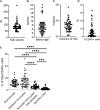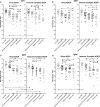Impact of IgG Isotype on the Induction of Antibody-Dependent Cellular Phagocytosis of HIV by Human Milk Leukocytes
- PMID: 35592337
- PMCID: PMC9110811
- DOI: 10.3389/fimmu.2022.831767
Impact of IgG Isotype on the Induction of Antibody-Dependent Cellular Phagocytosis of HIV by Human Milk Leukocytes
Abstract
Approximately 100,000 mother-to-child transmission (MTCT) events of HIV via human milk feeding occur each year. However, only about 15% of infants milk-fed by untreated HIV+ mothers become infected, suggesting a protective effect of the milk itself. Infants ingest 105-108 maternal leukocytes daily via milk, which remain functional beyond ingestion. Such function may be elicited by maternal milk antibody (Ab). Though IgA is dominant in milk, most HIV-specific milk Abs are of the IgG subclass, highlighting the importance of investigating the function of each IgG isotype in the milk context. Though Ab effector function mediated by the constant (Fc) domain via interaction with Fc Receptors (FcRs), such as Ab-dependent cellular phagocytosis (ADCP), are critical in protecting against HIV infection, ADCP is largely unexplored as it relates to mitigation of MTCT. Presently we report the ADCP activity of milk leukocytes against HIV particles and immune complexes (ICs), using 57 unique samples from 34 women, elicited by IgG1/2/3/4 of monoclonal (m)Ab 246-D. Granulocyte ADCP of HIV was most potent compared to other phagocytes when elicited by IgG1/3/4. IgG1/3 activated granulocytes similarly, exhibiting 1.6x-4.4x greater activity compared to IgG2/4, and a preference for virus compared to ICs. Notably, CD16- monocyte ADCP of a given target were unaffected by isotype, and CD16+ monocytes were poorly stimulated by IgG1. IgG2/4 elicited potent IC ADCP, and in terms of total leukocyte IC ADCP, IgG4 and IgG3 exhibited similar function, with IgG4 eliciting 1.6x-2.1x greater activity compared to IgG1/IgG2, and CD16+ monocytes most stimulated by IgG2. These data contribute to a more comprehensive understanding of Fc-mediated functionality of milk leukocytes, which is critical in order to develop therapeutic approaches to eliminating this route of MTCT, including mucosal administration of mAbs and/or a maternal vaccination aimed to elicit a potent milk Ab response.
Keywords: ADCP; HIV; IgG; human milk; lactation; mother-to-child HIV transmission; phagocytes; phagocytosis.
Copyright © 2022 Fox, Liu, Zolla-Pazner and Powell.
Conflict of interest statement
The authors declare that the research was conducted in the absence of any commercial or financial relationships that could be construed as a potential conflict of interest.
Figures





Similar articles
-
Phagocytosis of a Model Human Immunodeficiency Virus Target by Human Breast Milk Leukocytes Is Predominantly Granulocyte-Driven When Elicited by Specific Antibody.Breastfeed Med. 2019 Apr;14(3):185-192. doi: 10.1089/bfm.2018.0232. Epub 2019 Mar 13. Breastfeed Med. 2019. PMID: 30864817 Free PMC article.
-
Monoclonal Antibodies Specific for the V2, V3, CD4-Binding Site, and gp41 of HIV-1 Mediate Phagocytosis in a Dose-Dependent Manner.J Virol. 2017 Mar 29;91(8):e02325-16. doi: 10.1128/JVI.02325-16. Print 2017 Apr 15. J Virol. 2017. PMID: 28122974 Free PMC article.
-
Combined HIV-1 Envelope Systemic and Mucosal Immunization of Lactating Rhesus Monkeys Induces a Robust Immunoglobulin A Isotype B Cell Response in Breast Milk.J Virol. 2016 Apr 29;90(10):4951-4965. doi: 10.1128/JVI.00335-16. Print 2016 May 15. J Virol. 2016. PMID: 26937027 Free PMC article.
-
Transfer of antibody via mother's milk.Vaccine. 2003 Jul 28;21(24):3374-6. doi: 10.1016/s0264-410x(03)00336-0. Vaccine. 2003. PMID: 12850343 Review.
-
Antibody-Dependent Cellular Phagocytosis in Antiviral Immune Responses.Front Immunol. 2019 Feb 28;10:332. doi: 10.3389/fimmu.2019.00332. eCollection 2019. Front Immunol. 2019. PMID: 30873178 Free PMC article. Review.
Cited by
-
Preventing breast milk HIV transmission using broadly neutralizing monoclonal antibodies: One size does not fit all.Immun Inflamm Dis. 2024 Mar;12(3):e1216. doi: 10.1002/iid3.1216. Immun Inflamm Dis. 2024. PMID: 38533917 Free PMC article.
References
-
- World Health Organization Guideline: Updates on HIV and Infant Feeding: The Duration of Breastfeeding, and Support from Health Services to Improve Feeding Practices Among Mothers Living with HIV. World Health Organization Guidelines Approved by the Guidelines Review Committee. Geneva: : World Health Organization; (2016). - PubMed
Publication types
MeSH terms
Substances
Grants and funding
LinkOut - more resources
Full Text Sources
Medical
Miscellaneous

